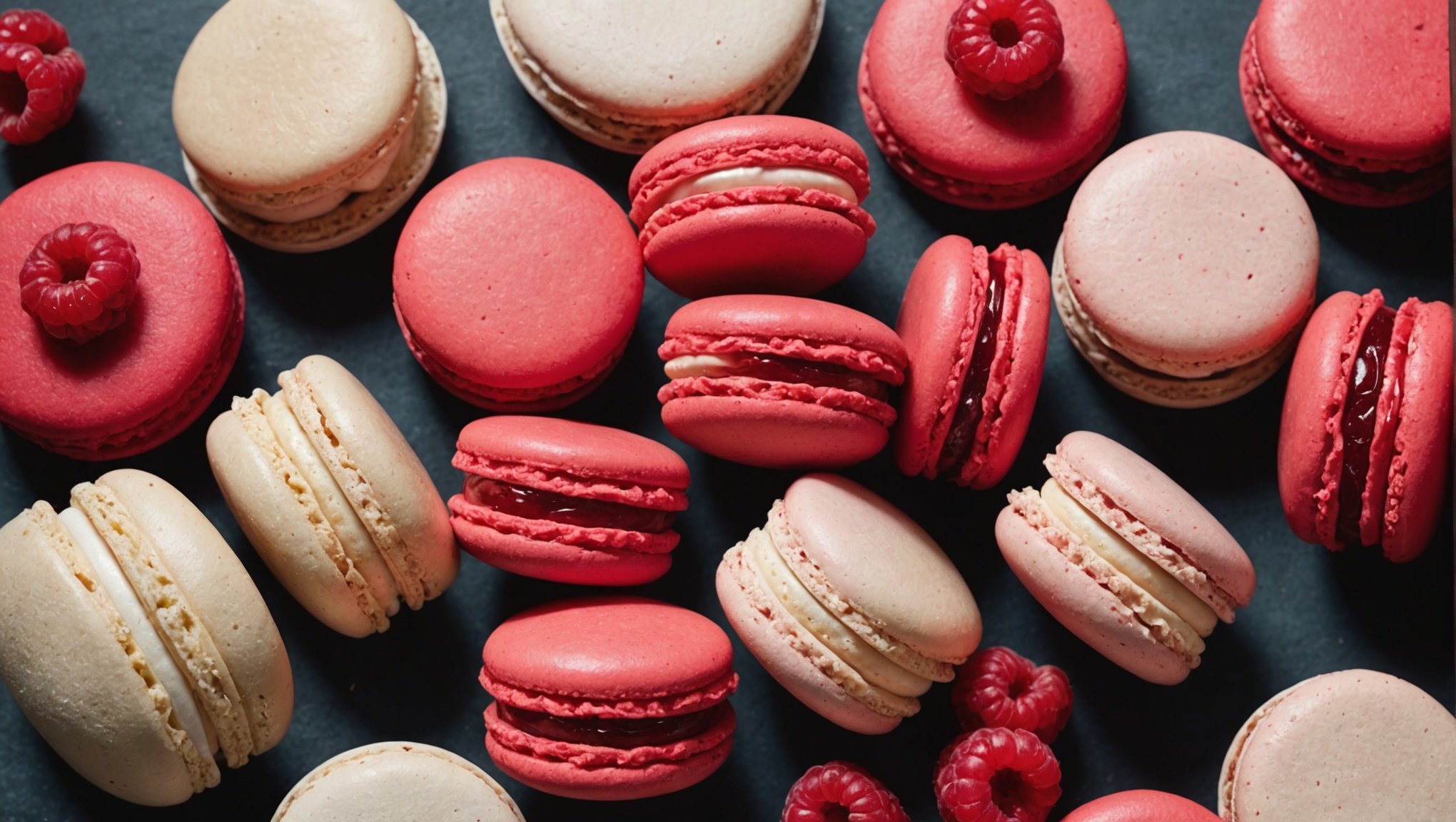Mastering the Art of French Macarons: Create Irresistible Raspberry-Filled Delights!
Understanding the Basics: Macarons vs Macaroons
Before we dive into the intricate world of French macarons, it’s essential to clarify the often-confused distinction between macarons and macaroons. Macarons are delicate, meringue-based cookies sandwiched with a creamy filling, typically made from ground almonds, sugar, and egg whites. In contrast, macaroons are coconut-based cookies that are often denser and chewier.
To make perfect French macarons, you need to understand the unique characteristics and requirements of these delicate treats. Here’s a brief overview of what sets them apart:
Also read : Mastering the Art of Gourmet Quiche Lorraine: Achieve a Flawlessly Crispy Crust!
| Characteristics | Macarons | Macaroons |
|---|---|---|
| Main Ingredients | Almond flour, sugar, egg whites | Coconut, sugar, egg whites |
| Texture | Delicate, crispy shell with a chewy interior | Dense, chewy |
| Appearance | Round, smooth shells with a distinctive “foot” | Irregular shape, often with a peak |
| Filling | Various fillings like ganache, buttercream, or jam | Typically plain or with a simple coating |
Key Ingredients and Tools for French Macarons
To embark on the journey of making French macarons, you’ll need a few essential ingredients and tools.
Ingredients
- Almond Flour: This is the backbone of your macaron shells. Ensure it is finely ground and sifted to avoid any lumps.
- Powdered Sugar: Combined with almond flour, it adds sweetness and helps in achieving the right texture.
- Egg Whites: Fresh egg whites are crucial for creating a stable meringue.
- Granulated Sugar: Used in making the French meringue.
- Food Coloring (Optional): For adding a pop of color to your macarons.
- Raspberry Filling: A sweet and tangy filling made from raspberries, sugar, and sometimes a touch of lemon juice.
Tools
- Scale: Accurate measurements are key. Weighing your ingredients on a scale is far more reliable than measuring by volume.
- Sifter: To aerate and combine the dry ingredients.
- Pastry Bag and Piping Tips: For piping the macaron batter into perfect circles.
- Baking Sheets and Parchment Paper: To ensure the macarons bake evenly and do not stick.
- Silicone Spatula: For folding the batter to the right consistency.
How to Make French Macarons
Making French macarons is a multi-step process that requires precision and patience. Here’s a detailed guide to help you through each step.
Also to discover : Master the Art of Baking Gourmet Olive and Rosemary Focaccia Topped with Sea Salt
1. Sift the Dry Ingredients
Sifting the almond flour and powdered sugar twice is crucial. This step not only combines the ingredients but also aerates them, ensuring a smooth and full interior. If your almond flour is chunky, discard the chunky bits rather than processing them, as over-processing can lead to oily almond flour and blotchy shells.
2. Make the French Meringue
Creating a stable French meringue is the foundation of perfect macarons. Here’s how you can do it:
- Beat Egg Whites: Start by beating the egg whites at room temperature until they become frothy.
- Add Granulated Sugar: Gradually add granulated sugar while continuing to beat the egg whites until stiff peaks form.
- Technique #1: Master the Meringue: Ensure the meringue is stable and not too runny. If it’s weak, you’ll encounter issues like hollow macarons or no feet.
3. Mix Macaron Batter / Macaronage
This step involves folding the dry ingredients into the meringue.
- Sift in Almond Flour Mixture: Gently sift the almond flour mixture into the meringue.
- Fold the Batter: Use a large silicone spatula to fold the batter until it reaches a lava-like consistency. This means the batter should be thick yet runny enough to slowly flow off the spatula.
- Technique #2: Macaronage: The proper consistency of the batter is critical. Over-mixed batter will be too runny, while under-mixed batter can lead to various issues. Check the consistency after about 50 folds by scooping the batter and dropping it back into the bowl. If the edges dissolve back into the batter within 10 seconds, it’s ready.
4. Pipe the Macaron Shells
Piping the macaron batter requires a bit of technique:
- Hold the Piping Bag: Hold the pastry bag at a straight 90° angle about ½-inch above the baking surface.
- Pipe the Macarons: Squeeze the batter to fill a 1½-inch circle without moving the piping bag up and down. Pipe the macarons about an inch apart for good air circulation.
5. Rest and Bake
Let the piped macarons rest at room temperature for about 30 minutes to an hour to form a skin. Then, bake them on preheated baking sheets lined with parchment paper.
6. Assemble the Macarons
Once the shells are baked and cooled, it’s time to assemble them.
- Prepare the Filling: For a raspberry filling, blend fresh raspberries with sugar and a touch of lemon juice until smooth.
- Pair the Shells: Match the shells by size and shape.
- Fill the Macarons: Place a small dollop of filling on one shell and sandwich it with another.
7. Mature the Macarons
Let the assembled macarons mature in an airtight container at room temperature for at least 24 hours. This allows the flavors to meld together and the shells to absorb the filling.
French Macaron Tips for Success
Mastering French macarons is not just about following a recipe; it’s about understanding the techniques and troubleshooting common issues.
Weighing Ingredients
Weighing your ingredients on a scale is crucial for accuracy. Measuring by volume can be unreliable and lead to inconsistent results.
Stable Meringue
A stable meringue is the foundation of perfect macarons. Weak meringue can result in hollow shells or shells without feet.
Macaronage
The macaronage step is where you mix the dry ingredients with the meringue and fold the batter to the right consistency. This step requires patience and practice to get it just right.
Detailed Tips and Tricks
Here are some additional tips to help you achieve perfect French macarons:
- Use Room Temperature Ingredients: Ensure all your ingredients, especially the egg whites, are at room temperature before starting.
- Avoid Over-Mixing: Over-mixing can lead to runny batter and poor texture. Stop folding once the batter reaches the lava-like consistency.
- Check Your Oven: Understand your oven’s temperature and humidity levels, as these can affect the baking process.
- Practice Makes Perfect: Don’t be discouraged if your first batch doesn’t turn out perfectly. Practice helps in refining your technique.
Raspberry Filling Recipe
Here’s a simple recipe for a delicious raspberry filling:
Ingredients
- 1 cup fresh raspberries
- 1/2 cup granulated sugar
- 1 tablespoon lemon juice
Instructions
- Blend the raspberries, sugar, and lemon juice until smooth.
- Strain the mixture to remove the seeds.
- Use this filling to sandwich your macaron shells.
Comparing Different Meringue Methods
French macarons can be made using different meringue methods, each with its own advantages and challenges.
| Meringue Method | Description | Advantages | Challenges |
|---|---|---|---|
| French Meringue | Made by gradually adding sugar to egg whites while beating. | Stable and easy to work with. | Requires precise timing and temperature control. |
| Italian Meringue | Made by pouring hot sugar syrup into egg whites while beating. | Very stable and less prone to weeping. | More complex and requires making a sugar syrup. |
| Swiss Meringue | Made by heating egg whites and sugar over a double boiler before beating. | Smooth and stable. | Requires careful heating to avoid scrambling the eggs. |
Customer Reviews and Insights
Here are some insights from bakers who have mastered the art of French macarons:
- “Macaron 101: A Comprehensive Guide” by Shinee is a game-changer. The step-by-step photos and detailed instructions made an intimidating task feel so very doable.
- “I have learned so much from just reading it and I’m excited to put my skills to the test this holiday season. With all of the troubleshooting tips, I feel confident I will succeed as I’ve had spotty and unreliable results in the past”.
- “The way you treat salted caramel stabilized with gelatin is terrific. If I had found this book earlier, I would have saved myself hours of watching YouTube videos”.
Mastering the art of French macarons is a journey that requires patience, practice, and a deep understanding of the techniques involved. With the right ingredients, tools, and a bit of persistence, you can create irresistible raspberry-filled delights that will impress anyone.
Remember, the key to perfect macarons lies in the details: precise measurements, stable meringue, and the right consistency of the batter. Whether you’re a beginner or a seasoned baker, the tips and tricks outlined here will help you on your path to creating flawless French macarons.
So, let’s get baking and make those perfect macarons
















